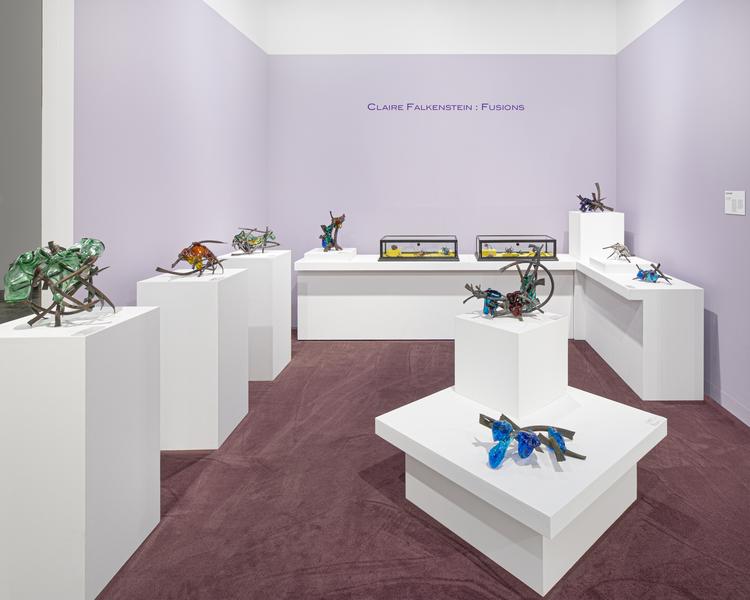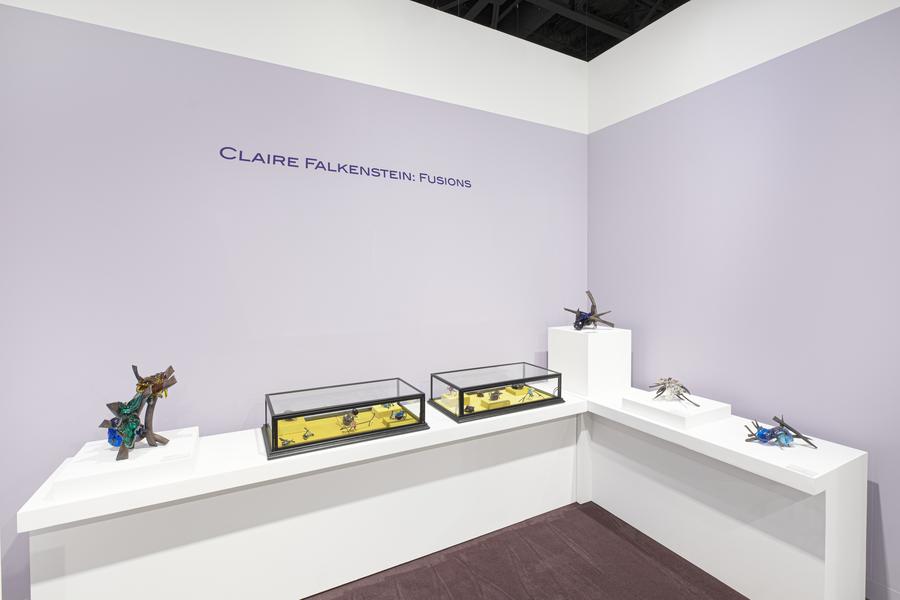Preview Days (by invitation only)
Wednesday, December 6, 11AM–7PM
Thursday, December 7, 11AM–7PM
Public Days
Friday, December 8, 11AM–6PM
Saturday, December 9, 11AM–6PM
Sunday, December 10, 11AM–6PM
Visit Michael Rosenfeld Gallery at Booth A17
Michael Rosenfeld Gallery is proud to participate in the Kabinett sector of Art Basel Miami Beach with an installation of twenty-four small-scale sculptures by Claire Falkenstein (1908–1997) from her celebrated Fusion series. Drawn from the holdings of the artist’s Foundation, the vast majority of the intimately sized works on view have never been publicly exhibited.
An interdisciplinary artist whose career spanned seven decades, Claire Falkenstein does not fit easily into any school or movement. Comprising a wide variety of mediums—wood, ceramic, and metal sculpting, painting, prints, jewelry, and more—the Fusions are perhaps the greatest testament to her artistic ingenuity, as they encompass a seemingly infinite array of shapes, scales, and palettes. Composed of welded metal and melted glass, the Fusions embody the dichotomies that exemplify the artist’s practice as a whole: solid and fluid, opaque and translucent, durable and fragile.
Falkenstein developed the Fusions after a trip to Venice, Italy inspired her to incorporate Murano glass into her sculpture. Material experimentation was a cornerstone of Falkenstein’s artistic practice throughout her career, and the Fusions came about through a methodical process of trial and error. After determining the precise temperature required to securely bond the glass and metal, Falkenstein developed the technique through which all Fusions were made: She first created a welded metal armature into which she placed pieces of glass in specific joints, “as a jeweler sets a jewel.” The object was then fired in a kiln until the two materials “fused,” allowing the final form to be determined by the uncontrolled interaction between the glass and metal. Scholar Maren Henderson writes of the Fusions:
“[Experiment], especially with an element of risk, was now a fully realized sculptural method. Process itself was an authentic aesthetic expression, as were chance and anti-form. The Fusions carried materials to the breaking point, testing their essential character to the degree of altering or even destroying them. Glass was heated well beyond becoming malleable to the point where it collapsed or even burned. Sheet metal surfaces were heated until they warped. Edges were torn, scarred or burned. Accidents were welcomed. And chance became a significant component of the process and the result.”[1]
Falkenstein’s prolific experimentation with the Fusion sculptures resulted in a diverse body of work. Fusions exist in a wide range of configurations, with some embodying a minimalist approach while others are densely complex; likewise, some examples exhibit a kaleidoscopic array of colors, while others contain only one or two.
Born and raised in the Pacific Northwest, Falkenstein felt a deep appreciation of the region’s natural beauty, and the visual contrast between the dense woodlands set against the flowing sea became a major trope in her art. Concentrating in art, philosophy, and anthropology at the University of California, Berkeley, Falkenstein was awarded her first solo exhibition by the East-West Gallery in San Francisco in 1930, the same year she graduated—a rare achievement for such a young artist. In 1933, Falkenstein received a grant to study at Mills College in Oakland under Cubist sculptor Alexander Archipenko. Her sculptures of the 1930s and 1940s comprise biomorphic abstractions rendered in wood and ceramic. Her work was first shown in New York City in 1944, when the Bonestell Gallery mounted a solo exhibition. In the late 1940s, she began teaching at the California School of Fine Arts (now the San Francisco Art Institute), where she met abstract expressionist painter Clyfford Still, who became a lifelong friend and encouraged her to take a more open-ended approach to composition.



